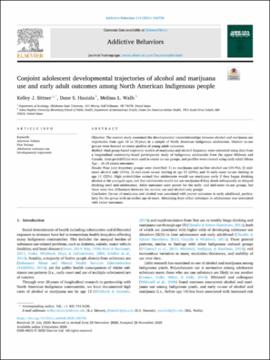| dc.contributor.author | Sittner, Kelley J. | |
| dc.contributor.author | Hautala, Dane S. | |
| dc.contributor.author | Walls, Melissa L. | |
| dc.date.accessioned | 2022-05-31T18:54:03Z | |
| dc.date.available | 2022-05-31T18:54:03Z | |
| dc.date.issued | 2021-03 | |
| dc.identifier | oksd_sittner_conjointadolescentdev_2021 | |
| dc.identifier.citation | Sittner, K. J., Hautala, D. S., & Walls, M. L. (2021). Conjoint adolescent developmental trajectories of alcohol and marijuana use and early adult outcomes among North American Indigenous people. Addictive Behaviors, 114, Article 106758. https://doi.org/10.1016/j.addbeh.2020.106758 | |
| dc.identifier.uri | https://hdl.handle.net/11244/335847 | |
| dc.description.abstract | Objective: The current study examined the developmental interrelationships between alcohol and marijuana use trajectories from ages 10 to 18 years in a sample of North American Indigenous adolescents. Distinct co-use groups were formed to create profiles of young adult outcomes. | |
| dc.description.abstract | Method: Dual group-based trajectory models of marijuana and alcohol frequency were estimated using data from a longitudinal community-based participatory study of Indigenous adolescents from the upper Midwest and Canada. Joint probabilities were used to create co-use groups, and profiles were created using early adult (Mean Age - 26.28 years) outcomes. | |
| dc.description.abstract | Results: Four joint trajectory groups were identified: 1) no marijuana and no/low alcohol use (34.4%), 2) mid-onset alcohol only (14%), 3) mid-onset co-use starting at age 13 (24%), and 4) early-onset co-use starting at age 11 (22%). High probabilities existed that adolescents would use marijuana early if they began drinking alcohol at the youngest ages, and that adolescents would not use marijuana if they drank infrequently or delayed drinking until mid-adolescence. Adult outcomes were poorer for the early- and mid-onset co-use groups, but there were few differences between the no/low use and alcohol-only groups. | |
| dc.description.abstract | Conclusion: Co-use of marijuana and alcohol was associated with poorer outcomes in early adulthood, particularly for the group with an earlier age of onset. Abstaining from either substance in adolescence was associated with better outcomes. | |
| dc.format | application/pdf | |
| dc.language | en_US | |
| dc.publisher | Elsevier BV | |
| dc.relation.ispartof | Addictive Behaviors, 114 | |
| dc.relation.uri | https://www.ncbi.nlm.nih.gov/pubmed/33316589 | |
| dc.rights | This material has been previously published. In the Oklahoma State University Library's institutional repository this version is made available through the open access principles and the terms of agreement/consent between the author(s) and the publisher. The permission policy on the use, reproduction or distribution of the material falls under fair use for educational, scholarship, and research purposes. Contact Digital Resources and Discovery Services at lib-dls@okstate.edu or 405-744-9161 for further information. | |
| dc.subject.mesh | Adolescent | |
| dc.subject.mesh | Adult | |
| dc.subject.mesh | Alcohol Drinking | |
| dc.subject.mesh | Canada | |
| dc.subject.mesh | Child | |
| dc.subject.mesh | Humans | |
| dc.subject.mesh | Indigenous Peoples | |
| dc.subject.mesh | Longitudinal Studies | |
| dc.subject.mesh | Marijuana Smoking | |
| dc.subject.mesh | Marijuana Use | |
| dc.subject.mesh | Substance-Related Disorders | |
| dc.subject.mesh | United States | |
| dc.subject.mesh | Young Adult | |
| dc.title | Conjoint adolescent developmental trajectories of alcohol and marijuana use and early adult outcomes among North American Indigenous people | |
| dc.date.updated | 2022-05-31T14:36:52Z | |
| osu.filename | oksd_sittner_conjointadolescentdev_2021.pdf | |
| dc.description.peerreview | Peer reviewed | |
| dc.identifier.doi | 10.1016/j.addbeh.2020.106758 | |
| dc.description.department | Sociology | |
| dc.type.genre | Article | |
| dc.type.material | Text | |
| dc.subject.keywords | Adolescent substance use | |
| dc.subject.keywords | American Indians | |
| dc.subject.keywords | Developmental trajectories | |
| dc.subject.keywords | First Nations | |
| dc.subject.keywords | Substance Abuse | |
| dc.subject.keywords | Pediatric | |
| dc.subject.keywords | Underage Drinking | |
| dc.subject.keywords | Prevention | |
| dc.subject.keywords | Drug Abuse (NIDA Only) | |
| dc.subject.keywords | Alcoholism, Alcohol Use and Health | |
| dc.subject.keywords | 2.3 Psychological, social and economic factors | |
| dc.subject.keywords | Stroke | |
| dc.subject.keywords | Oral and gastrointestinal | |
| dc.subject.keywords | 1117 Public Health and Health Services | |
| dc.subject.keywords | 1701 Psychology | |
| dc.relation.oaversion | Accepted version | |
| dc.relation.oaurl | https://www-ncbi-nlm-nih-gov.argo.library.okstate.edu/pmc/articles/PMC7785682/ | |
| dc.identifier.author | ORCID: 0000-0002-8588-4487 (Sittner, KJ) | |
| dc.identifier.author | ScopusID: 55189348500 (Sittner, KJ) | |
| dc.identifier.author | ORCID: 0000-0002-6049-970X (Hautala, DS) | |
| dc.identifier.author | ScopusID: 57193600395 (Hautala, DS) | |
| dc.identifier.author | ORCID: 0000-0001-6324-457X (Walls, ML) | |
| dc.identifier.author | ScopusID: 14065623300 (Walls, ML) | |
